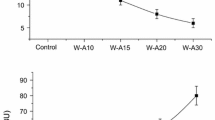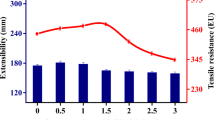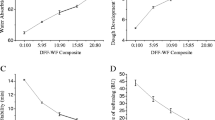Abstract
The inclusion of plant material in bread formulations is a global trend, but research on the mechanisms of its effect on the structural and baking performance of the dough is lacking. Herein, edible chrysanthemum (Chrysanthemum morifolium Ramat.) powder (CP) was substituted for wheat flour at 3–15 wt% and its effects on dough structure and rheology, bread physicochemical properties, and aroma profile were investigated. The inclusion of CP reduced the relative crystallinity and structure orderliness of starch in terms of X-ray diffraction (XRD) and Fourier transform infrared (FTIR) spectroscopy analysis. Steady-state shear and oscillation tests showed that the inclusion of CP resulted in an enhanced viscoelastic behavior of dough, implying an increase in the resistance of the dough system to flow and deformation, which caused a decrease in specific volume and softness of bread compared to the control (bread without CP). The large oscillatory amplitude oscillation shear (LAOS) tests indicated that doughs exhibited I behavior (strain thinning). The scanning electron microscopy (SEM) observation further confirmed these findings. Significantly, formulations with 3 and 6 wt% CP not only improved the rheological and structural properties of doughs but also enriched the aroma profile of bread compared to the control. Furthermore, sensory evaluators reported that bread enriched with 6% CP scored highest in appearance, texture, and overall acceptability, meaning a product with a high sensory appeal to consumers. This work provides valuable information for an in-depth study of the relationship between bread quality and the rheological behavior and structural properties of the dough.





Similar content being viewed by others
Data Availability
All data generated or analyzed during this study are included in this published article.
References
Amini Khoozani, A., Kebede, B., Bekhit, E. -D., & A. (2020). Rheological, textural and structural changes in dough and bread partially substituted with whole green banana flour. LWT-Food Science and Technology, 126, 109252. https://doi.org/10.1016/j.lwt.2020.109252
Bianchi, F., Giuberti, G., Cervini, M., & Simonato, B. (2022). Fortification of durum wheat fresh pasta with Maqui (Aristotelia chilensis) and its effects on technological, nutritional, sensory properties, and predicted glycemic index. Food and Bioprocess Technology, 15(7), 1563–1572. https://doi.org/10.1007/s11947-022-02838-9
Bigne, F., Romero, A., Ferrero, C., Puppo, M. C., & Guerrero, A. (2017). Rheological and microstructural study of wheat doughs partially replaced with mesquite flour (Prosopis alba) and added with transglutaminase. Food and Bioprocess Technology, 10(5), 819–830. https://doi.org/10.1007/s11947-017-1869-4
Bonnand-Ducasse, M., Della Valle, G., Lefebvre, J., & Saulnier, L. (2010). Effect of wheat dietary fibres on bread dough development and rheological properties. Journal of Cereal Science, 52(2), 200–206. https://doi.org/10.1016/j.jcs.2010.05.006
Cao, Y., Jiang, L., Suo, W., Deng, Y., Zhang, M., Dong, S., Guo, P., Chen, S., & Li, H. (2021). Influence of emulsifiers and enzymes on dough rheological properties and quality characteristics of steamed bread enriched with potato pulp. Food Chemistry, 360, 130015. https://doi.org/10.1016/j.foodchem.2021.130015
Dello Staffolo, M., Sato, A. C. K., & Cunha, R. L. (2017). Utilization of plant dietary fibers to reinforce low-calorie dairy dessert structure. Food and Bioprocess Technology, 10(5), 914–925. https://doi.org/10.1007/s11947-017-1872-9
Demirkesen, I., Campanella, O. H., Sumnu, G., Sahin, S., & Hamaker, B. R. (2013). A study on staling characteristics of gluten-free breads prepared with chestnut and rice flours. Food and Bioprocess Technology, 7(3), 806–820. https://doi.org/10.1007/s11947-013-1099-3
Gómez, M., González, J., & Oliete, B. (2012). Effect of extruded wheat germ on dough rheology and bread quality. Food and Bioprocess Technology, 5(6), 2409–2418. https://doi.org/10.1007/s11947-011-0519-5
Guo, P., Yu, J., Copeland, L., Wang, S., & Wang, S. (2018). Mechanisms of starch gelatinization during heating of wheat flour and its effect on in vitro starch digestibility. Food Hydrocolloids, 82, 370–378. https://doi.org/10.1016/j.foodhyd.2018.04.012
Han, C. W., Ma, M., Zhang, H. H., Li, M., & Sun, Q. J. (2020). Progressive study of the effect of superfine green tea, soluble tea, and tea polyphenols on the physico-chemical and structural properties of wheat gluten in noodle system. Food Chemistry, 308, 125676. https://doi.org/10.1016/j.foodchem.2019.125676
Hemdane, S., Jacobs, P. J., Dornez, E., Verspreet, J., Delcour, J. A., & Courtin, C. M. (2016). Wheat (Triticum aestivum L.) bran in bread making: A critical review. Comprehensive Reviews in Food Science and Food Safety, 15(1), 28–42. https://doi.org/10.1111/1541-4337.12176
Hernandez-Aguilar, C., Dominguez-Pacheco, A., Valderrama-Bravo, C., Cruz-Orea, A., Martínez Ortiz, E., & Ordonez-Miranda, J. (2020). Photoacoustic spectroscopy in the characterization of bread with turmeric addition. Food and Bioprocess Technology, 13(12), 2104–2119. https://doi.org/10.1007/s11947-020-02546-2
Hyun, K., Kim, S. H., Ahn, K. H., & Lee, S. J. (2002). Large amplitude oscillatory shear as a way to classify the complex fluids. Journal of Non-Newtonian Fluid Mechanics, 107(1–3), 51–65. https://doi.org/10.1016/S0377-0257(02)00141-6
Jia, S., Cao, J., Dai, Y., Hou, H., Wang, W., Ding, X., & Zhang, H. (2021). Effect of potassium carbonate on rheological properties of dough and its mechanism. LWT-Food Science and Technology, 152, 112335. https://doi.org/10.1016/j.lwt.2021.112335
Joyner, H. S. (2018). Explaining food texture through rheology. Current Opinion in Food Science, 21, 7–14. https://doi.org/10.1016/j.cofs.2018.04.003
Kiskini, A., Kapsokefalou, M., Yanniotis, S., & Mandala, I. (2011). Effect of iron fortification on physical and sensory quality of gluten-free bread. Food and Bioprocess Technology, 5(1), 385–390. https://doi.org/10.1007/s11947-011-0651-2
Kotsiou, K., Sacharidis, D. D., Matsakidou, A., Biliaderis, C. G., & Lazaridou, A. (2022). Physicochemical and functional aspects of composite wheat-roasted chickpea flours in relation to dough rheology, bread quality and staling phenomena. Food Hydrocolloids, 124, 107322. https://doi.org/10.1016/j.foodhyd.2021.107322
Kowalski, S., Mikulec, A., Mickowska, B., Skotnicka, M., & Mazurek, A. (2022). Wheat bread supplementation with various edible insect flours. Influence of chemical composition on nutritional and technological aspects. LWT-Food Science and Technology, 159, 113220. https://doi.org/10.1016/j.lwt.2022.113220
Liu, Y. Y., Sun, W. H., Li, B. Z., Shang, N., Wang, Y., Lv, W. Q., Li, D., & Wang, L. J. (2021). Value-added application of Platycodon grandiflorus (Jacq.) A.DC. roots (PGR) by ultrasound-assisted extraction (UAE) process to improve physicochemical quality, structural characteristics and functional properties. Food Chemistry, 363, 130354. https://doi.org/10.1016/j.foodchem.2021.130354
Ma, F., Chen, C., Sun, G., Wang, W., Fang, H., & Han, Z. (2012). Effects of high pressure and CaCl2 on properties of salt-soluble meat protein gels containing locust bean gum. Innovative Food Science & Emerging Technologies, 14, 31–37. https://doi.org/10.1016/j.ifset.2011.12.001
Ma, S., Wang, Z., Liu, H., Li, L., Zheng, X., Tian, X., Sun, B., & Wang, X. (2022). Supplementation of wheat flour products with wheat bran dietary fiber: Purpose, mechanisms, and challenges. Trends in Food Science & Technology, 123, 281–289. https://doi.org/10.1016/j.tifs.2022.03.012
Ma, Y., Xu, D., Sang, S., Jin, Y., Xu, X., & Cui, B. (2021). Effect of superheated steam treatment on the structural and digestible properties of wheat flour. Food Hydrocolloids, 112, 106362. https://doi.org/10.1016/j.foodhyd.2020.106362
Meeus, Y., Janssen, F., Wouters, A. G. B., Delcour, J. A., & Moldenaers, P. (2019). Linear and non-linear rheology of bread doughs made from blends of wheat (Triticum aestivum L.) and rye (Secale cereale L.) flour. Food and Bioprocess Technology, 13(1), 159–171. https://doi.org/10.1007/s11947-019-02393-w
Milde, L. B., Ramallo, L. A., & Puppo, M. C. (2012). Gluten-free bread based on tapioca starch: Texture and sensory studies. Food and Bioprocess Technology, 5(3), 888–896. https://doi.org/10.1007/s11947-010-0381-x
Mildner-Szkudlarz, S., Rozanska, M., Piechowska, P., Waskiewicz, A., & Zawirska-Wojtasiak, R. (2019). Effects of polyphenols on volatile profile and acrylamide formation in a model wheat bread system. Food Chemistry, 297, 125008. https://doi.org/10.1016/j.foodchem.2019.125008
Mironeasa, S., Iuga, M., Zaharia, D., & Mironeasa, C. (2018). Rheological analysis of wheat flour dough as influenced by grape peels of different particle sizes and addition levels. Food and Bioprocess Technology, 12(2), 228–245. https://doi.org/10.1007/s11947-018-2202-6
Moreira, R., Chenlo, F., & Torres, M. D. (2012). Rheology of gluten-free doughs from blends of chestnut and rice flours. Food and Bioprocess Technology, 6(6), 1476–1485. https://doi.org/10.1007/s11947-012-0927-1
Ning, J., Hou, G. G., Sun, J., Wan, X., & Dubat, A. (2017). Effect of green tea powder on the quality attributes and antioxidant activity of whole-wheat flour pan bread. LWT - Food Science and Technology, 79, 342–348. https://doi.org/10.1016/j.lwt.2017.01.052
Nissen, L., Samaei, S. P., Babini, E., & Gianotti, A. (2020). Gluten free sourdough bread enriched with cricket flour for protein fortification: Antioxidant improvement and Volatilome characterization. Food Chemistry, 333, 127410. https://doi.org/10.1016/j.foodchem.2020.127410
Özcan, M. M. (2022). The effect of ginger (Zingiber officinale) powders at different concentrations on bioactive compounds, antioxidant activity, phenolic constituents, nutrients and sensory characteristics of wheat bread. International Journal of Gastronomy and Food Science, 28, 100532. https://doi.org/10.1016/j.ijgfs.2022.100532
Ozyigit, E., Eren, İ, Kumcuoglu, S., & Tavman, S. (2020). Large amplitude oscillatory shear (LAOS) analysis of gluten-free cake batters: The effect of dietary fiber enrichment. Journal of Food Engineering, 275, 109867. https://doi.org/10.1016/j.jfoodeng.2019.109867
Ozkoc, S. O., & Seyhun, N. (2015). Effect of gum type and flaxseed concentration on quality of gluten-free breads made from frozen dough baked in infrared-microwave combination oven. Food and Bioprocess Technology, 8(12), 2500–2506. https://doi.org/10.1007/s11947-015-1615-8
Paciulli, M., Rinaldi, M., Cirlini, M., Scazzina, F., & Chiavaro, E. (2016). Chestnut flour addition in commercial gluten-free bread: A shelf-life study. LWT - Food Science and Technology, 70, 88–95. https://doi.org/10.1016/j.lwt.2016.02.034
Parenti, O., Guerrini, L., Cavallini, B., Baldi, F., & Zanoni, B. (2020). Breadmaking with an old wholewheat flour: Optimization of ingredients to improve bread quality. LWT - Food Science and Technology, 121, 108980. https://doi.org/10.1016/j.lwt.2019.108980
Petrović, J., Kovalenko, V., Svirid, A., Stojković, D., Ivanov, M., & Kostić, M. (2022). Individual stereoisomers of verbenol and verbenone express bioactive features. Journal of Molecular Structure, 1251, 131999. https://doi.org/10.1016/j.molstruc.2021.131999
Pérez-Quirce, S., Ronda, F., Lazaridou, A., & Biliaderis, C. G. (2017). Effect of microwave radiation pretreatment of rice flour on gluten-free breadmaking and molecular size of β-glucans in the fortified breads. Food and Bioprocess Technology, 10(8), 1412–1421. https://doi.org/10.1007/s11947-017-1910-7
Pu, D., Zhang, H., Zhang, Y., Sun, B., Ren, F., Chen, H., & He, J. (2019). Characterization of the aroma release and perception of white bread during oral processing by gas chromatography-ion mobility spectrometry and temporal dominance of sensations analysis. Food Research International, 123, 612–622. https://doi.org/10.1016/j.foodres.2019.05.016
Ribotta, P. D., Pérez, G. T., Añón, M. C., & León, A. E. (2010). Optimization of additive combination for improved soy–wheat bread quality. Food and Bioprocess Technology, 3(3), 395–405. https://doi.org/10.1007/s11947-008-0080-z
Sabanis, D., Tzia, C., & Papadakis, S. (2007). Effect of different raisin juice preparations on selected properties of gluten-free bread. Food and Bioprocess Technology, 1(4), 374–383. https://doi.org/10.1007/s11947-007-0027-9
Salinas, M. V., Carbas, B., Brites, C., & Puppo, M. C. (2015). Influence of different carob fruit flours (Ceratonia siliqua L.) on wheat dough performance and bread quality. Food and Bioprocess Technology, 8(7), 1561–1570. https://doi.org/10.1007/s11947-015-1527-7
Sun, D., Wu, M., Xu, H., Shang, N., Gao, F., Wang, Y., & Zheng, Z. (2021). The bioactive properties and quality attributes of Chrysanthemum morifolium Ramat as affected by pulsed vacuum drying. Drying Technology, 1-15. https://doi.org/10.1080/07373937.2021.1998105
Tang, M. X., Lei, Y. C., Wang, Y., Li, D., & Wang, L. J. (2021). Rheological and structural properties of sodium caseinate as influenced by locust bean gum and κ-carrageenan. Food Hydrocolloids, 112, 106251. https://doi.org/10.1016/j.foodhyd.2020.106251
Tao, H., Wang, P., Ali, B., Wu, F., Jin, Z., & Xu, X. (2016). Fractionation and reconstitution experiments provide insight into the role of wheat starch in frozen dough. Food Chemistry, 190, 588–593. https://doi.org/10.1016/j.foodchem.2015.05.123
Tao, H., Zhu, X. F., Nan, B. X., Jiang, R. Z., & Wang, H. L. (2021). Effect of extruded starches on the structure, farinograph characteristics and baking behavior of wheat dough. Food Chemistry, 348, 129017. https://doi.org/10.1016/j.foodchem.2021.129017
Tufaro, D., Bassoli, A., & Cappa, C. (2022). Okra (Abelmoschus esculentus) Powder production and application in gluten-free bread: Effect of particle size. Food and Bioprocess Technology, 15(4), 904–914. https://doi.org/10.1007/s11947-022-02784-6
Turksoy, S., Erturk, M. Y., & Kokini, J. (2021). Behavior of semolina, hard, soft wheat flour dough at different aging times and temperatures through LAOS properties and molecular interactions of proteins. Journal of Food Engineering, 301, 110549. https://doi.org/10.1016/j.jfoodeng.2021.110549
Wronkowska, M., Haros, M., & Soral-Śmietana, M. (2012). Effect of starch substitution by buckwheat flour on gluten-free bread quality. Food and Bioprocess Technology, 6(7), 1820–1827. https://doi.org/10.1007/s11947-012-0839-0
Xu, H., Wu, M., Zhang, X., Wang, B., Wang, S., Zheng, Z., Li, D., & Wang, F. (2022a) Application of blanching pretreatment in herbaceous peony (Paeonia lactiflora Pall.) flower processing: Improved drying efficiency, enriched volatile profile and increased phytochemical content. Industrial Crops and Products, 188, 115663. https://doi.org/10.1016/j.indcrop.2022a.115663
Xu, H., Wu, M., Wang, Y., Wei, W., Sun, D., Li, D., Zheng, Z., & Gao, F. (2022b). Effect of combined infrared and hot air drying strategies on the quality of Chrysanthemum (Chrysanthemum morifolium Ramat.) cakes: Drying behavior, aroma profiles and phenolic compounds. Foods, 11(15), 2240. https://doi.org/10.3390/foods11152240
Yildirim-Mavis, C., Yilmaz, M. T., Dertli, E., Arici, M., & Ozmen, D. (2019). Non-linear rheological (LAOS) behavior of sourdough-based dough. Food Hydrocolloids, 96, 481–492. https://doi.org/10.1016/j.foodhyd.2019.05.055
Zhao, X., Li, D., Wang, L. J., & Wang, Y. (2022). Rheological properties and microstructure of a novel starch-based emulsion gel produced by one-step emulsion gelation: Effect of oil content. Carbohydrate Polymers, 281, 119061. https://doi.org/10.1016/j.carbpol.2021.119061
Funding
This work was supported by China Agricultural Research System of MOF and MARA (CARS-21), National Natural Science Foundation of China (No. 32171912) and Beijing Municipal Natural Science Foundmedation (No. 6182022).
Author information
Authors and Affiliations
Contributions
Huihuang Xu: data curation, formal analysis, writing—original Draft. Min Wu: funding acquisition, project administration, writing—reviewing and editing. Nan Shang: writing—reviewing and editing. Wenguang Wei: conceptualization, methodology. Fei Gao: methodology.
Corresponding author
Ethics declarations
Conflict of Interest
The authors declare no conflict of interests.
Additional information
Publisher's Note
Springer Nature remains neutral with regard to jurisdictional claims in published maps and institutional affiliations.
Supplementary Information
Below is the link to the electronic supplementary material.
Rights and permissions
Springer Nature or its licensor (e.g. a society or other partner) holds exclusive rights to this article under a publishing agreement with the author(s) or other rightsholder(s); author self-archiving of the accepted manuscript version of this article is solely governed by the terms of such publishing agreement and applicable law.
About this article
Cite this article
Xu, H., Wu, M., Shang, N. et al. Fortification of Wheat Bread with Edible Chrysanthemum (Chrysanthemum morifolium Ramat.): Unraveling the Mechanisms of Dough Rheology and Bread Quality Changes. Food Bioprocess Technol 16, 82–97 (2023). https://doi.org/10.1007/s11947-022-02924-y
Received:
Accepted:
Published:
Issue Date:
DOI: https://doi.org/10.1007/s11947-022-02924-y




